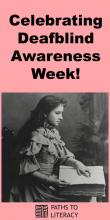Celebrating Deafblind Awareness Week

Deafblind Awareness Week is observed each year the last week in June, in honor of Helen Keller's birthday on June 27th. We celebrate all those who promote literacy for children who have a combined vision and hearing loss!
Established in 1984, Deafblind Awareness Week calls attention to the achievements and needs of individuals who are deafblind. Many people think of Helen Keller when they hear the term "deafblind" and assume that people who are deafblind have no usable vision or hearing. In fact, most people who are deafblind have some degree of usable vision and/or hearing.
Deafblind Specialist Barbara Miles provides a helpful overview of deafblindness, which is available on the website of the National Center for Deaf-Blindness.
It may seem that deaf-blindness refers to a total inability to see or hear. However, in reality deaf-blindness is a condition in which the combination of hearing and visual losses in children and youth cause “such severe communication and other developmental and educational needs that they cannot be accommodated in special education programs solely for children with deafness or children with blindness" [34 CFR 300.8(c)(2)] or multiple disabilities. Children who are called deaf-blind are singled out educationally because impairments of sight and hearing require thoughtful and unique educational approaches in order to ensure that children with this disability have the opportunity to reach their full potential.
A person who is deaf-blind has a unique experience of the world. For people who can see and hear, the world extends outward as far as his or her eyes and ears can reach. For the young child who is deaf-blind, the world is initially much narrower. If the child is profoundly deaf and totally blind, his or her experience of the world extends only as far as the fingertips can reach. Such children are effectively alone if no one is touching them. Their concepts of the world depend upon what or whom they have had the opportunity to physically contact.
If a child who is deaf-blind has some usable vision and/or hearing, as many do, her or his world will be enlarged. Many children called deaf-blind have enough vision to be able to move about in their environments, recognize familiar people, see sign language at close distances, and perhaps read large print. Others have sufficient hearing to recognize familiar sounds, understand some speech, or develop speech themselves. The range of sensory impairments included in the term “deaf-blindness” is great.
